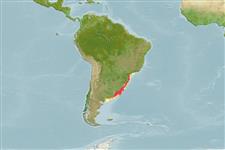>
Pleuronectiformes (Flatfishes) >
Paralichthyidae (Large-tooth flounders)
Etymology: Paralichthys: Greek, para = the side of + Greek, ichthys = fish + Greek, suffix, oides = similar to (Ref. 45335).
Eponymy: Alcide Charles Victor Dessalines d’Orbigny (1802–1857) was a traveller, collector, illustrator and naturalist. [...] (Ref. 128868), visit book page.
More on author: Valenciennes.
Environment: milieu / climate zone / depth range / distribution range
Écologie
marin; saumâtre démersal; océanodrome; profondeur 1 - 45 m (Ref. 43588), usually 1 - 20 m (Ref. 43588). Subtropical; 23°S - 41°S
Southwest Atlantic: Rio de Janeiro, Brazil to at least Mar de la Plata, Argentina.
Length at first maturity / Taille / Poids / Âge
Maturity: Lm ?, range 39 - ? cm
Max length : 83.0 cm TL mâle / non sexé; (Ref. 127691); common length : 32.0 cm SL mâle / non sexé; (Ref. 43588); âge max. reporté: 11 années (Ref. 127691)
Épines dorsales (Total) : 0; Rayons mous dorsaux (Total) : 71 - 77; Épines anales: 0; Rayons mous anaux: 52 - 59; Vertèbres: 35 - 36. Body shape oval, with the greatest breadth 2.5 times in length. Eyes are on the left side, close together, and equally in advance. Teeth are in a single series, sharply pointed. Dorsal fin origin aligned with eyes. Lateral line arched over the pectoral fin. Eye side of the body slightly rough, with finely ciliated scales (Ref. 3157).
Populations are found in shallow coastal marine waters (Ref. 127691). They enter coastal lagoons (Ref. 36453). Nursery grounds are found in estuaries, coastal lagoons and brackish surf waters (Ref. 127691). Adults feed on pelagic and benthic species of crustaceans (penaeids and brachyurans), and lesser important fishes (Ref. 43588). Juveniles mainly feed on plolychaetes (Ref. 127691).
Life cycle and mating behavior
Maturité | Reproduction | Frai | Œufs | Fécondité | Larves
Distinct pairing (Ref. 205).
Figueiredo, J.L. and N.A. Menezes, 2000. Manual de peixes marinhos do sudeste do Brasil. VI.Teleostei (5). Museu de Zoologia, Universidade de São Paulo. Brazil. 116 p. (Ref. 36453)
Statut dans la liste rouge de l'IUCN (Ref. 130435: Version 2024-2)
Menace pour l'homme
Harmless
Utilisations par l'homme
Pêcheries: commercial
Outils
Articles particuliers
Télécharger en XML
Sources Internet
Estimates based on models
Preferred temperature (Ref.
123201): 13.4 - 22.8, mean 16.1 °C (based on 118 cells).
Phylogenetic diversity index (Ref.
82804): PD
50 = 0.5000 [Uniqueness, from 0.5 = low to 2.0 = high].
Bayesian length-weight: a=0.00676 (0.00432 - 0.01057), b=3.11 (2.98 - 3.24), in cm total length, based on LWR estimates for this species & Genus-body shape (Ref.
93245).
Niveau trophique (Ref.
69278): 3.5 ±0.54 se; based on food items.
Résilience (Ref.
120179): Faible, temps minimum de doublement de population : 4,5 à 14 années (K = 0.12).
Fishing Vulnerability (Ref.
59153): Moderate to high vulnerability (53 of 100).
Nutrients (Ref.
124155): Calcium = 64.7 [29.4, 115.1] mg/100g; Iron = 0.905 [0.455, 1.626] mg/100g; Protein = 16.3 [13.9, 19.6] %; Omega3 = 0.173 [0.086, 0.325] g/100g; Selenium = 24.3 [11.4, 54.1] μg/100g; VitaminA = 11.9 [3.3, 46.1] μg/100g; Zinc = 0.681 [0.446, 1.021] mg/100g (wet weight);
